How Does Sediment Affect Stormwater Infrastructure and Streams?
/0 Comments/in Biofilters, Green Infrastructure, Municipal and Infrastructure Journal, Sediment Control, Stormwater Management, Water Abatement /by Tanya RichardsThe Trickle-Down Effect of Green Roofs
/0 Comments/in Green Infrastructure, Municipal and Infrastructure Journal, Stormwater Management, Water Abatement /by Tanya RichardsSustainable Stormwater Management in Canada
/0 Comments/in Municipal and Infrastructure Journal, Stormwater Management, Water Abatement /by Tanya RichardsErosion Control on Steep Slopes and Embankments
/6 Comments/in Environment, Erosion Control, Municipal and Infrastructure Journal, Sediment Control, Streambank Restoration, Water Abatement /by Tanya RichardsErosion Control
As land development happens in hilly countryside, more erosion control on steep slopes and embankments is needed. Especially in areas that experience heavy rainfall. Steep slopes and embankments that have no vegetation or cover are especially vulnerable to erosion issues. Erosion can cause damage to not only the landscape, but any infrastructure surrounding the project. It is important to protect the hillside from erosion during and after the project is complete.
Erosion is basically the displacement of soil from one area to another. On steep slopes and embankments erosion is caused primarily by water, especially by heavy rainfall. Rain that falls onto the exposed ground dislodges soil particles which are then carried away down the slope by the flowing water. However, it is the resulting destabilization of slope that creates an even greater danger as rocks and trees roots become exposed.
There are several ways of controlling erosion on steep slopes and embankments.
 Natural Solutions
Natural Solutions
The most effective, natural way to control soil erosion on steep slopes and embankments is to plant vegetation. Not only will the grass, fescue and leaves help to slow down raindrops as they fall, the roots of the plants will also help to hold the soil together, making it harder for water to wash it away.
However, when planting vegetation on a slope to stop erosion, you need to keep in mind that what you’re planting is just as important as the planting. Though grasses can create a groundcover that can absorb some moisture, they have less effective storm water filtration ability compared to native ground cover. Various typical erosion control seed specifications are available as well as custom seed blends to mimic the native grasses in the area.
Artificial Solutions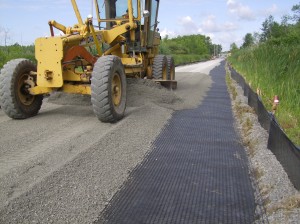
Other than planting vegetation, there are also a variety of artificial solutions you can use. For instance, the use of geomats has become popular over the last few years. Geomats are water permeable polymers that are used to help fix soil elements, grass and small plant roots, and have been shown to work extremely well, especially on barren slopes that have no vegetation. There are even biodegradable geomats that are now being produced that are designed to prevent erosion and give freshly planted vegetation a chance to grow.
Building Terraces
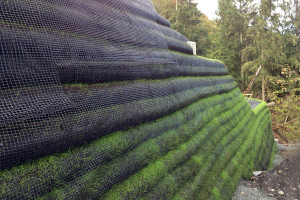 Building terraces is also another way to help prevent soil erosion. When most people think of terraces as a method of erosion control, some may think of the incas in Peru. There the natives implemented the early methods of erosion control on the Andes mountains for many centuries. Terrace walls help to hold soil in place while providing a convenient surface to plant a variety of plants. Building terraces can be as simple as using a couple of wooden blocks to create a terrace wall, or it could be more sophisticated and involve the use of engineered stones, concrete retaining wall blocks or a living green wall solution.
Building terraces is also another way to help prevent soil erosion. When most people think of terraces as a method of erosion control, some may think of the incas in Peru. There the natives implemented the early methods of erosion control on the Andes mountains for many centuries. Terrace walls help to hold soil in place while providing a convenient surface to plant a variety of plants. Building terraces can be as simple as using a couple of wooden blocks to create a terrace wall, or it could be more sophisticated and involve the use of engineered stones, concrete retaining wall blocks or a living green wall solution.
Soil Composition Enhancement
You could also control erosion by controlling the soil itself. As heavy rain tends to be the biggest culprit for soil erosion on slopes and embankments, by controlling the composition of the soil, you 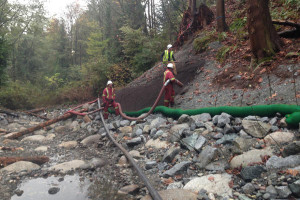 could control the effect that water has on it and therefore the likelihood that it will be eroded. Soil that is high in organic material tends to absorb more water, therefore, using organic material such as compost, aged mulch, or a manure can go a long way in preventing soil erosion.
could control the effect that water has on it and therefore the likelihood that it will be eroded. Soil that is high in organic material tends to absorb more water, therefore, using organic material such as compost, aged mulch, or a manure can go a long way in preventing soil erosion.
The best solution (or multiple solutions) is best determined by evaluating each slope individually.
Save
Best Erosion Control Practices
/6 Comments/in Environment, Erosion Control, Stormwater Management, Water Abatement /by Tanya RichardsBest Erosion Control Practices
With any kind of construction, you are bound to face challenges with controlling erosion and the deposit of sediments. The possibility of erosion is elevated by changes being made to the environment of the site. Water runoff contributes to the deposit of sediments and increased pollutants. These negative environmental impacts can all be kept at bay if a few Best Management Practices are implemented at the right time. We’ve outlined these best erosion control practices below for your reference.
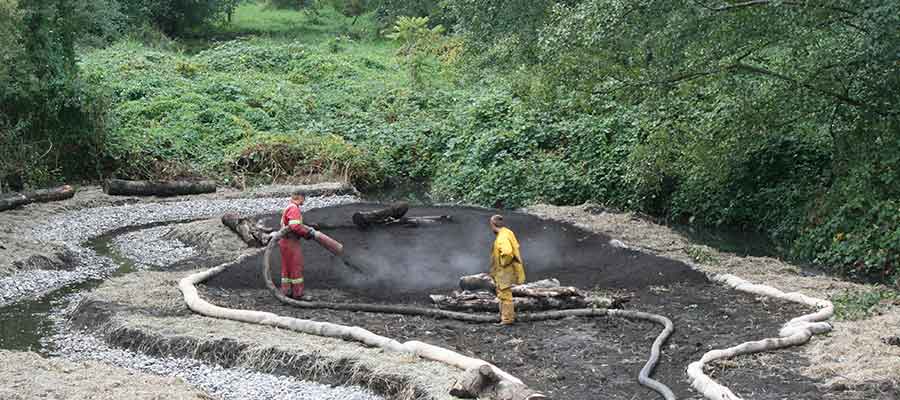
Consider Unique Site Attributes
First you must carefully assess the site that you are working on, as every site is unique. Everything from the intensity, duration, and frequency of rainfall needs to be considered, as does the local geography and landscape. Sites that are on a slope or an incline will be more prone to erosion. The type of soil that the site is on must also be assessed. If the site is on soil that is very easy to erode, more drastic steps may have to be taken to reduce or stop erosion.
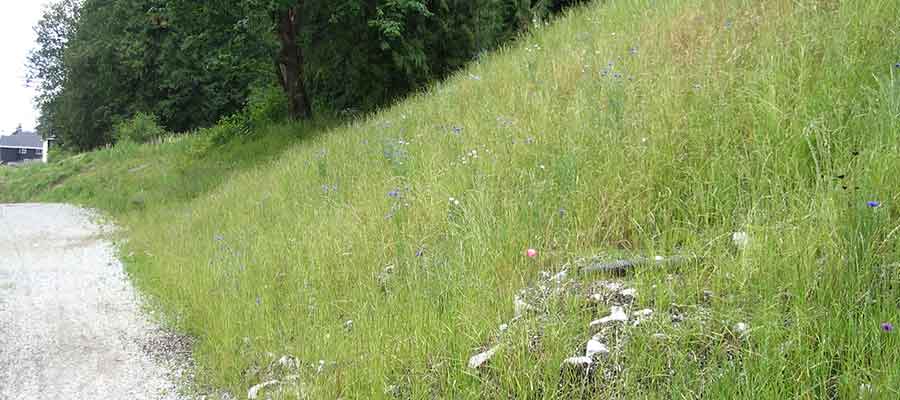
Develop a Project Plan
Once the site has been assessed, you can develop your erosion control plan. Taking care especially when it comes to the order in which different tasks are carried out. For instance, if you are carrying out construction over a wide area, you can begin excavating areas of the site in sections. Systematically move through different areas using a predetermined route, rather than disturbing the whole site. This will help reduce the amount of land that is left exposed for long periods, thereby decreasing erosion.

Managing Water Flow
Controlling water on your site will also be very important. The construction of dikes and ditches to control the flow of water is prudent, especially when they are constructed at the top and bottom of slopes and embankments. Constructing temporary slope drains will also help in mitigating the effects of erosion, especially when these are constructed in cut/fill transitions and steep slopes around the site.
Sediment that runs off a construction site can cause damage to the environment if it ends up in the wrong place, especially if it ends up in water ways surrounding the site. This could upset the ecosystem. Constructing silt fences and sediment traps will go a long way to preventing potential damage to the environment during to construction. Sediment controls should be constructed around the perimeter of the site, at the entrances and exits to the site, and at water inlets and outlets.
Managing Water Pollution
Reducing water pollution caused by erosion and sediment should be a high priority on site. This involves ensuring that a construction site near a water way has the proper erosion and sediment controls in place. If there is to be excavation then it is important to prevent erosion and sediment loss. Prior to the beginning of construction you can put filter sock in place around the edge of the water way. This will protect the water from any heavy sediment run off throughout construction.
Stabilization of soil, on site, after construction may also be necessary. One of the best ways to ensure that you maintain good soil stability is by protecting the existing vegetation that is on the site, including trees, shrubs and forbs. Areas where there is no longer any vegetation can be treated with a seeded compost erosion control blanket – controlling erosion and re-vegetating the area in one step.
Conclusion
In order to best address erosion and sediment controls, it is necessary to first, asses your site. Second, you must develop a project plan. Finally, implement your plan by managing water flow, using engineered structures and protecting the natural vegetation, thus reducing water pollution.
Overwhelming? We recommend partnering with an Environmental Consultant who is familiar with the Erosion and Sediment Control bylaws in the municipality where the project is located. eg: City of Surrey bylaws
We hope you find this article helpful. Please share!
Save
Is Coloured Mulch Safe for Your Garden
/0 Comments/in Construction Landscape Journal, Landscape Journal, Landscape Mulch, Water Abatement /by Tanya RichardsIs Coloured Mulch Safe for Your Garden?
The use of coloured mulch has increased over the last number of years, as the bold and rich colour offers an attractive look for landscaping while continuing to offer the benefits of mulching. Unlike natural, non-dyed mulch, which tends to fade to gray, coloured mulch can hold its colour for a year or longer.
However, with these benefits, public concern has also been raised regarding the use of coloured mulch. The primary question is: Is Coloured Mulch Safe for Your Garden?
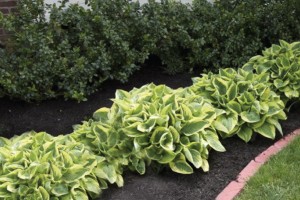
What about the dye?
The typical dyes used for colouring mulch are iron oxide-based and carbon-based. Iron oxide, used to produce red mulch, is commonly known as rust, and is used extensively in paints, cosmetics, and even used to dye flowers. Carbon, used to produce black mulch, is an element often used for ink or paint. Both bases for these dyes are considered natural, non-toxic and safe for handling. Most other colours are made with vegetable-based colourants, also from naturally occurring elements.
A study (“Are Mulch Colorants Safe”) conducted by the Mulch and Soil Council, determined that colourants typically used for coloured mulch are deemed non-toxic and when used properly, would not have any negative effects on the environment.
Of course, a savvy customer should ask about the product they are purchasing, and the company should know about their product. For example, at Denbow, we know that our mulch is coloured with non-hazardous, safe for the environment, ingredients.
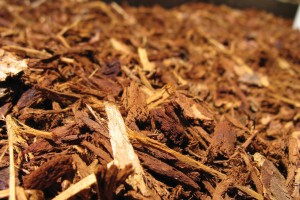
What is in the wood?
As the colourant used in coloured mulch has been generally deemed safe for use, eyes have turned to the content of the wood. The use of recycled wood is a beneficial practice for the environment, yet depending on the content of the wood, harmful toxins (such as lead) could be lingering from past uses.
When purchasing coloured mulch, then, it is important to consider the wood content. In an effort to improve the quality of our products, Denbow produces a number of our own materials, including processing our own mulches. We work with select sources of material to minimize foreign material in our finished products. Our red and black coloured mulches are made of locally recycled wood, free from these contaminants.
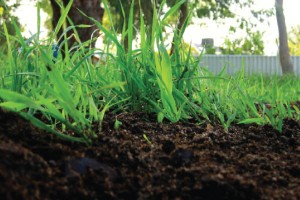
Will it affect the soil?
There is a concern that when using wood mulch, the carbon of the wood will interact with the nitrogen in the soil, using the nitrogen to help the decomposition process, but in turn, pulling the nutrients from the soil. Coloured mulch actually decomposes at a slower rate than regular wood mulch, which means the nitrogen is removed from the soil at a slower rate.
Use of a nitrogen-rich fertilizer is encouraged, as for whether or not mulch is used, the soil can benefit from the implementation of a regular fertilization program. It is recommended when adding new mulch, to take the time to remove old mulch or be sure to cultivate your existing mulch on a monthly basis in order to help healthy decomposition.
At the end of the day, if you are looking for a pop of colour to refresh a garden bed, or seeking to landscape a new area and considering an alternative to the natural mulch, coloured mulch is a safe and beautiful option. Is coloured mulch safe for your garden? Yes, Denbow’s coloured mulch definitely is.
BCSLA Showcase
/0 Comments/in Announcement, Environment, Erosion Control, Green Infrastructure, Sediment Control, Slope Stabilization, Stormwater Management, Streambank Restoration, Water Abatement /by Tanya RichardsTomorrow and Saturday we’re participating in the BC Society of Landscape Architects (BCSLA) 2016 Annual Conference and Showcase. Landscape Architects, visit us in booth #16 to check out our models of Cascadia Green Wall System and EcoBlanket.
Looking forward to meeting you and focusing on “Shifting Currents: Rethinking our Relationships with Water”.
EnviroDyke project for City of Abbotsford
/in Municipal and Infrastructure Journal, Stormwater Management, Water Abatement /by Tanya RichardsToday we are adding on to the EnviroDyke at Clayburn Creek for the City of Abbotsford.
This dyke is created using three Filtrexx FilterSoxx stacked in a pyramid. The FilterSoxx are filled using a blower truck; they are being filled with growing media compost and Terraseeded by the truck during the filling process.
Denbow’s Envirodyke system was chosen by the City of Abbotsford to:
– assist in resolving lowland flooding,
– protect environmentally important areas of the watershed,
– provide an integrated bio-engineered alternative to hard structures


